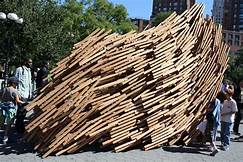Sukkot In Jerusalem
- Reuben Beiser

- Oct 6, 2020
- 2 min read
As I sit in my Sukkah, there is no doubt what this week’s blog should be about: distinguishing design from decoration.
The Sukkah is first and foremost a ritual object, a booth facilitating the annual Jewish obligation to reside in a temporary structure for seven days. There are regulations which define the size, shape and materials permitted, and these are surprisingly flexible. Nevertheless, square wood or cloth Sukkot are by far the most common.

Once built, Sukkot are decorated, often with a mix of homemade drawings, commercially produced posters, and re-purposed Christmas lights. Because the Sukkah is meant to replace one’s permanent residence, some families decorate to a higher degree, hanging tapestries and rugs from the walls or illustrating the walls with artistic renditions of cityscapes, landscapes, and ancient ruins. The Samaritans have the tradition of decorating their Sukkot entirely with fruit.

Common among the decorations are the main themes of the holiday: the four plant species used during holiday worship, the seven biblical plant species of the land of Israel, the Tabernacle from the desert wanderings and then the Temple and scenes from Jerusalem. Popular verses from the Bible and liturgy provided texts to put on the walls, and the aramaic invitation ceremony, ushering Biblical characters as guests (Ushpizin) into the Sukkah is similarly ubiquitous.
With so many options easily available – yes, you can find Sukkot Decorations on Amazon and Pinterest – an undecorated Sukkah is rare, but still more rare is the designed sukkah. Proper design is a synthesis between the programmatic requirements of an object and a conceptual vision. Properly executed, such synthesis creates true beauty, whereas decoration can, at best, make something ‘pretty’.
[Pictured above: full scale conceptual Sukkot from competitions in New York and Toronto]
Artists and architects have long recognized that the Sukkah, with its regulations on one side and its wealth of cultural and spiritual messages on the other provided the perfect foil for a design exercise. In 2005 I initiated the Jerusalem Sukkah Design Competition for just this reason. Similar competitions and installations preceded and followed, providing a plethora of examples as to how a kosher, functional Sukkah can be DESIGNED.
[Pictured above: models entered into the Jerusalem Sukkah Design Competition (2005-8)]
As I contemplate the walls, decorations and roofing of my Sukkah, I am transported back in time through the pages of history, through the pages of the Talmud, through the verses of the Bible; from the Exodus from Egypt to Joshua’s march on Jericho, to Bar Kochba, to the ghetto of Lodz, to my childhood, Kibbuzim, friend's houses; to the experiences I pass on to my children, to imagining the Sukkot my grandchildren will build. All these thoughts and ideas can be filtered and reified into a structure that while necessarily temporary, connects us to the eternal. Successful design translates an idea into physical form. The Sukkah can and should help us do that.

A common blessing amongst educated Jews during the Sukkot holiday is, loosely translated, “May you merit to sit in the Whale Skin Sukkah”. Allow me to explain by paraphrasing and wishing that everyone merit sitting in a Sukkah of meaning.




















Comments